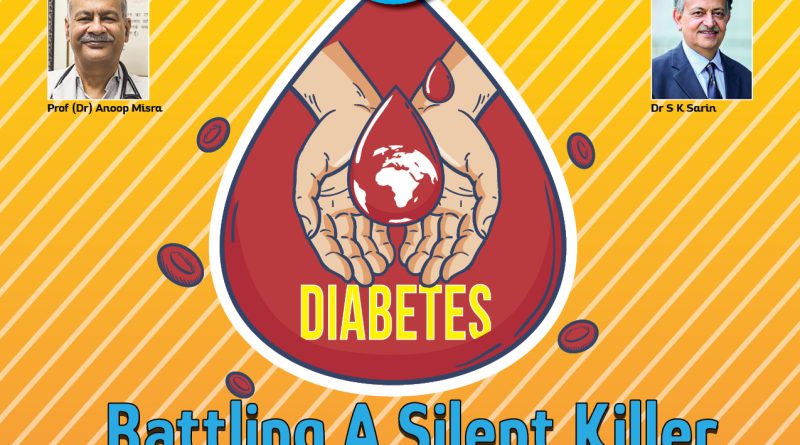Confronting the Diabetes Epidemic
Dear Readers,
Over the decades, we’ve witnessed groundbreaking changes in the medical field, with Indian doctors and experts contributing significantly to global advancements. Double Helical, a comprehensive national health magazine, serves as a platform to acknowledge innovations, individuals, products, and services transforming India’s healthcare sector, paving the way for affordable, high-quality, and inclusive healthcare.
This time, we highlight the present scenario of diabetes titled “Battling A Silent Killer” as the cover story. Recent reports indicate a significant rise in diabetes cases in India. Shockingly, one in every five diabetes patients worldwide is Indian. We delve into the complexities of the modern diabetes crisis, exploring innovative approaches for prevention and management.
Understanding the root causes of diabetes empowers individuals to manage their symptoms effectively and adopt preventive measures. While some risk factors are modifiable, others are inherent to an individual’s genetic makeup. Early diagnosis of diabetes enables prompt intervention and facilitates the implementation of strategies for optimal self-care.
In India, more than 65 million people suffer from diabetes, and nearly 8 percent of the population above 18 years old is affected. This number is projected to increase to 100 million by the year 2030, making India second only to China in diabetes prevalence. Shockingly, one in every five diabetes patients worldwide is Indian. A study revealed that 37 percent of Delhi’s population suffers from diabetes or pre-diabetes. Indians have a genetic predisposition to diabetes, with nearly 75 percent of patients with type 2 diabetes having a family history of the disease.
It is noted that there is a significant rise in diabetes cases in India, with over a hundred million individuals now affected, marking a 44% increase over four years. Studies by the Indian Council of Medical Research (ICMR) suggest that while 11.4% of the population is diabetic, a larger proportion, 15.3%, is in a pre-diabetic state. This surge may be attributed to heightened awareness leading to improved detection, as well as advancements in diabetes care prolonging the lifespan of affected individuals who pass on genetic predispositions to future generations.
However, this rise poses both short-term and long-term challenges due to the intricate epidemiology of diabetes in the country. The determinants are multifaceted, shaped by malnutrition at both ends of life – under-nutrition during foetal development and early childhood, juxtaposed with over-nutrition in adulthood. Socioeconomic changes and market dynamics further contribute to the burden, with the burgeoning middle class’s inclination towards fast food, sugary beverages, and sedentary lifestyles exacerbating the issue.
In this issue, our special story focuses on liver disease. Liver health is a critical yet often overlooked aspect of overall well-being. It is imperative to know the intricate functions of the liver and effectively combat the rising prevalence of liver diseases. We explore the challenges, innovations, and expert insights shaping the prevention, diagnosis, and treatment of liver ailments.
As we know, liver diseases are influenced by various factors encompassing obesity, alcohol abuse, and inadequate awareness regarding Hepatitis B and C viruses. Additionally, indiscriminate drug use significantly contributes to liver ailments. The liver, an indispensable organ, executes over 500 essential tasks crucial for maintaining bodily functions. Its pivotal role in digestion includes detoxification, protein synthesis, and the production of digestive enzymes vital for breaking down food. As a cornerstone of the digestive system, the liver’s health is paramount.
Historically, civilisations recognized the liver’s significance dating back to ancient times. In 2000 BC, the Babylonians recognised the liver’s centrality in bodily functions, long before the discovery of the heart. Analogously, the liver is often likened to a pillar supporting the body, emphasising its structural robustness and importance. Despite its resilience, negligence towards liver health can lead to severe consequences. While the liver initially tolerates dietary and lifestyle indiscretions, prolonged neglect can result in adverse outcomes.
Alcohol consumption remains a significant cause of liver diseases, with over 48 percent of such cases at ILBS attributed to high alcohol intake. Despite its social acceptance, alcohol abuse has led to increased consumption across all social, age, and gender groups. Raising awareness about responsible alcohol consumption and destigmatising, as well as seeking help for alcohol-related issues are imperative in preventing liver diseases associated with alcohol abuse. We need to remember that the liver is the primary site for synthesising major proteins crucial for various bodily functions. Bile synthesised in the liver aids in fat digestion, while the organ also plays a pivotal role in fat and carbohydrate metabolism, underscoring its metabolic significance.
Like these, the current issue is packed with many more interesting and thought-provoking stories. Happy reading!
Thanks and regards
Amresh K Tiwary,
Editor-in-Chief

